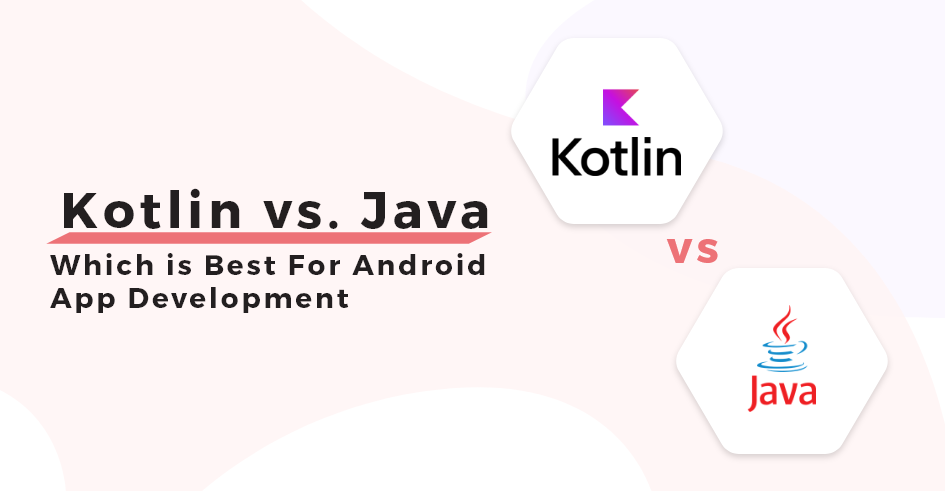Every software development process follows a set of steps that are crucial for launching high-quality software. Based on my professional experience, it is essential to have clearly defined steps in software development, whether you are a startup or a large corporation. A streamlined development process is the key to success.
As a custom software development company with extensive experience in real estate, fintech, and healthcare projects, we strongly advocate for a streamlined product development process. We understand how to make these software development process steps work in practice, not just on paper. Therefore, in this article, we will discuss the software development lifecycle steps and the different management methodologies available.
So, without further ado, let’s get started.
What is the Software Development Process?
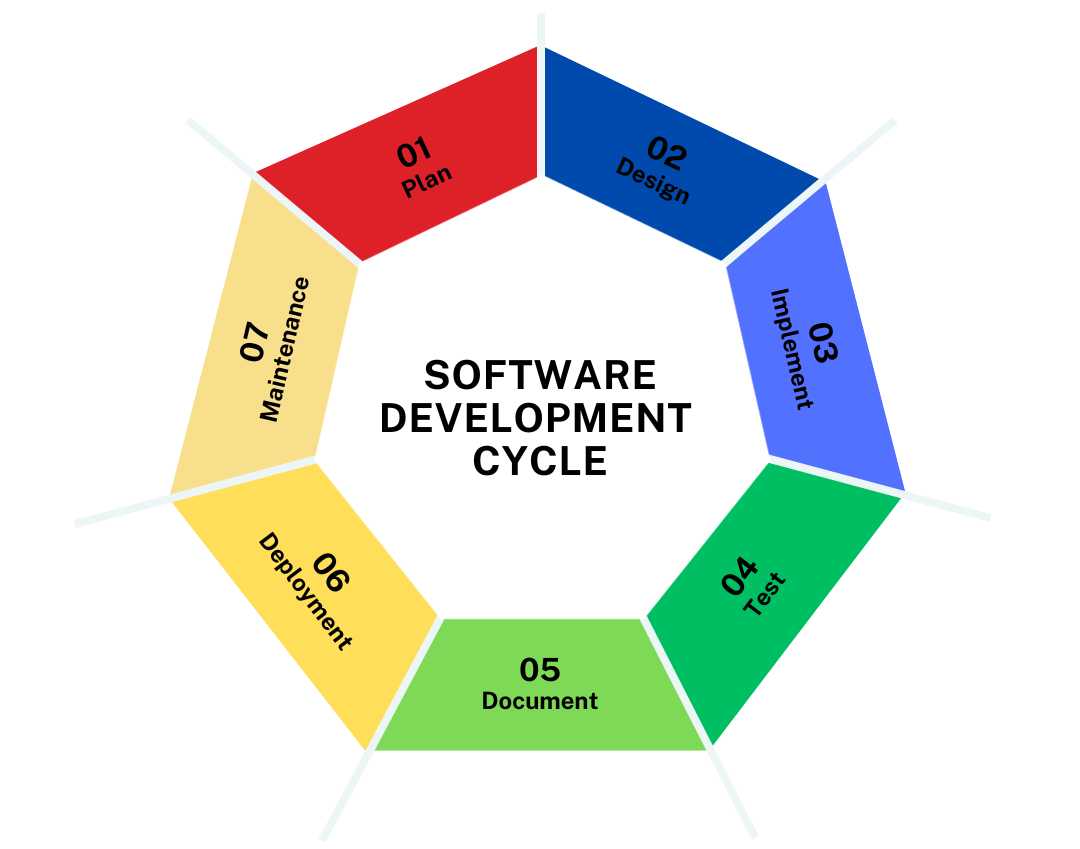
The software development process is a dynamic and iterative logical approach designed to create programmed software that fulfills unique business or personal objectives. This involves a series of steps, including research, data and process flow design, technical documentation, comprehensive testing, debugging, and iterative deployment.
Why do we need a Software Development Process?
A Software Development Process is like a roadmap for building computer programs. It helps make things organized, ensures the quality of the software, and makes sure projects are done well in the world of computer programming. Some of the reasons are below:
Tailored Solutions
Custom software addresses specific client or business needs, ensuring a precise fit for unique requirements.
Real-World Problem Solving
Developers create solutions that tackle practical challenges, contributing to advancements across diverse industries.
Personalized Applications
Individual or niche business needs are met through software, exemplified by a pharmacy owner using specialized tools for inventory and billing.
Software engineering follows a structured approach throughout the development life cycle, ensuring organized phases from planning to maintenance. Various methodologies, including Agile, Waterfall, Scrum, and Kanban, are employed for efficient project management. These frameworks contribute to well-organized and successful software development.
Why is Software Development Process Important?
The Need for a Software Development Process indicates the significance and necessity of a structured and organized approach to software creation. In software development, a “process” refers to a systematic set of steps, methods, or procedures that are followed to design, build, test, deploy, and maintain software applications. This process is vital for several reasons:
Complexity of Software Development
Software development involves intricate tasks, from defining requirements to coding, testing, and deployment. A well-defined process helps manage and simplify these complexities, ensuring a smoother and more efficient workflow.
Quality Assurance
A structured development process incorporates quality assurance measures at various stages. This helps identify and rectify issues early in the development lifecycle, ensuring the delivery of high-quality software products.
Project Management
A clear development process provides a roadmap for project management. It helps in setting realistic timelines, allocating resources effectively, and tracking progress throughout the development lifecycle.
Client Satisfaction
Following a well-defined process increases the likelihood of delivering software that meets or exceeds client expectations. This is crucial for maintaining client satisfaction and building a positive reputation in the software development industry.
Risk Mitigation
Software Development Process involves inherent uncertainties and risks. A systematic process allows for the identification and mitigation of potential risks, reducing the likelihood of project failures or costly errors.
Adaptability to Change
Requirements in software development are subject to change due to evolving business needs or external factors. A structured process enables teams to adapt to changes efficiently, ensuring the flexibility required in dynamic development environments.
Efficient Resource Utilization
Properly defined processes help in the optimal utilization of resources, including human resources, time, and budget. This efficiency is critical for delivering projects within deadlines and budget constraints.
Documentation and Knowledge Transfer
A structured development process encourages documentation at each stage. This documentation is invaluable for knowledge transfer among team members, future maintenance, and understanding the rationale behind design decisions.
Software Development Process Example
For instance, you are developing a Mobile Patrol app. Here is how the Software Development Process helps a smooth deliverable:
Efficiency and Organization
A structured development process ensures that the Mobile Patrol app is efficiently designed and organized, enhancing the overall development workflow. The development team follows a systematic approach, from planning features to deploying critical alerts. This efficiency is vital for creating a well-functioning app.
Quality Assurance
The process incorporates rigorous testing phases, ensuring the Mobile Patrol app is free of errors and functions reliably. The testing phase involves checking the accuracy of safety information and critical alerts. This quality assurance guarantees a trustworthy app for users.
Meeting User Needs
The Software Development Process involves understanding and addressing user needs, such as providing important safety information and news. Mobile Patrol is designed to connect users to critical alerts and safety information for specific locations, meeting the user’s need for real-time updates on places they care about.
Adaptability to Change
The process allows for adaptability to changing requirements or technological advancements, ensuring the Mobile Patrol app stays relevant. As safety information needs evolve, the development team can adapt the app to include new features or update existing ones, ensuring it remains a valuable tool for users.
Effective Project Management
A well-defined Software Development Process contributes to effective project management, aiding in the timely delivery of the Mobile Patrol app. By following a structured roadmap, the development team can efficiently manage tasks, from connecting users to safety information to delivering critical alerts in a timely manner.
User Satisfaction
A systematic development process contributes to creating a user-friendly and reliable app, enhancing user satisfaction. As Mobile Patrol is designed to provide users with safety information and news for locations they care about, ensuring a positive and satisfying user experience.
What is PDLC?
PDLC stands for Product Development Lifecycle (PDLC). It’s like a step-by-step journey that a product takes from being just an idea to becoming a fully finished and useful thing that people can use. It involves planning, designing, creating, releasing, and making the Software Development Process better over time.
The Product Development Lifecycle consists of five key steps:
- Product Conceptualization: Involves idea generation, market research, functional analysis, technical analysis, feasibility analysis, ROI assessment, and prototype development.
- Product Architecture and Design: Encompasses the design of technical architecture, workflow diagrams, and database design based on business specifications.
- Product Development: Development teams employ methodologies like Waterfall or Agile, conducting unit tests, integration tests, and performance tests. Alpha releases are created for internal testing.
- Product Release: Beta releases are introduced to external users, gathering feedback for further improvements. The public release involves broad announcements, PR activities, and widespread availability.
- Product Realization and Future Upgrades: Involves continuous monitoring of product usage, growth, bug fixes, and enhancements based on customer impact.
Example of PDLC
Let’s break down the Product Development Lifecycle (PDLC) using the example of a Mobile Wallet App, like Chase Mobile App:
Product Conceptualization
Idea Generation: Someone thinks of creating a Mobile Wallet App that works like the Chase Mobile App, allowing users to manage their money on their phones.
Market Research: They study what people need and check if they are interested in such an app.
Prototype Development: They create a basic version, kind of like a rough sketch, to see how it might work.
Product Architecture and Design
Technical Design: The development team plans how the app will work behind the scenes.
Workflow Diagrams: They create maps showing how users will move through the app.
Database Design: They figure out how to store and organize information, like user account details.
Product Development:
Coding: Developers start writing the actual code for the app based on the designs.
Testing: They check if everything works as it should, like making sure you can log in and see your account balance.
Alpha Release: A version of the app is ready, but it’s mostly for the development team to test.
Product Release
Beta Release: The app is shared with a limited number of users, like a trial run.
Feedback: Users try it out and share their thoughts. If there are issues, the team fixes them.
Public Release: The app is officially launched for everyone to download and use.
Product Realization and Future Upgrades
Monitoring: The team keeps an eye on how people are using the app and if there are any problems.
Enhancements: They make improvements based on feedback and may add new features.
Bug Fixes: If there are any issues, they’re fixed to keep the app running smoothly.
In the end, the Mobile Wallet App goes through these stages, evolving from an idea to a fully functional and user-friendly application, just like the development journey of the Chase Mobile App.
What is SDLC?
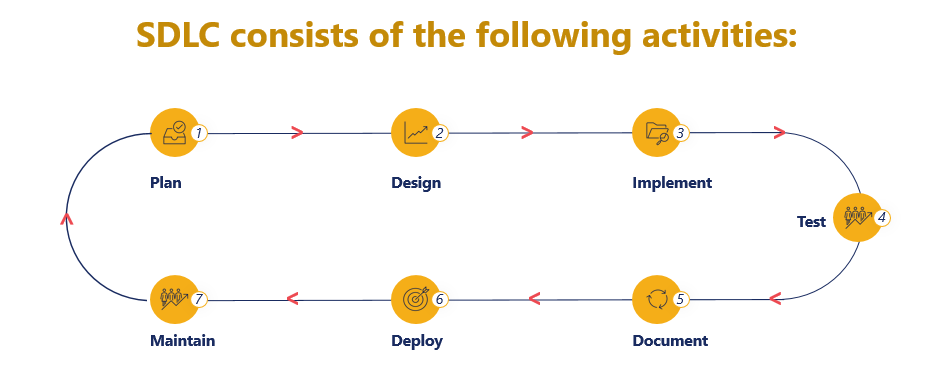
SDLC stands for Software Development Life Cycle (SDLC). It is a methodical approach utilized by the software industry to create, design, and test top-notch software. SDLC produces software that is of high quality, meets or exceeds customer expectations, and is completed within the estimated time and cost. The activities involved are:
- Plan: Requirements analysis and scope documentation.
- Design: Creating efficient solutions based on business requirements.
- Implement: Write code as per the analyzed requirements.
- Test: Identifying errors, bugs, or flaws in the software.
- Document: Comprehensive documentation of project activities.
- Deployment: Release and installation of approved software.
- Maintaining: Post-operational phase involving modifications, bug fixes, and system performance monitoring.
Example of SDLC
Let’s understand the Software Development Life Cycle (SDLC) using the example of the T Mobile Internet App:
1. Planning:
Identifying Needs: T Mobile recognizes the need for a user-friendly app to manage home internet services.
Setting Goals: The goal is to create an app that allows users to control their home internet easily.
2. Design:
User Interface (UI) Design: Designers plan how the app will look and feel, ensuring a simple and intuitive interface.
Architecture Design: Developers outline how the app will function, considering factors like user location.
3. Development:
Coding: Developers write the code for the app based on the design specifications.
Quick Setup Feature: A specific focus is placed on making the setup process quick and hassle-free.
4. Testing:
Quality Assurance: The app undergoes testing to ensure it works smoothly and meets quality standards.
Location Feature Testing: The team verifies that the location-based features, emphasizing “Location matters,” function accurately.
5. Deployment:
App Release: The app is officially released for users to download and install.
User Guidance: T Mobile guides downloading and using the app.
6. Maintenance:
Monitoring: The development team monitors how users interact with the app and addresses any issues.
Updates: Periodic updates are released, incorporating user feedback and introducing new features.
Bug Fixes: If any bugs or issues arise, the team works to fix them promptly to maintain a smooth user experience.
Throughout this Software Development Life Cycle, the app like T Mobile Internet App transforms from an idea to a practical tool for users, enabling them to easily manage their home internet services with the convenience of quick setup and location-specific features.
How does SDLC address security?
In the past, importance of security in custom software development was separate from SDLC, which led to hidden bugs and increased security risks. Nowadays, security is an integral part of the SDLC, and you can address security concerns by following DevSecOps practices and conducting security assessments throughout the entire process.
DevSecOps
DevSecOps integrates security testing at every stage of software development, encouraging collaboration between developers, security specialists, and operations teams to build software that can withstand modern threats. It also ensures that security assurance activities such as code review, architecture analysis, and penetration testing are integral to development efforts.
Software Development Methodologies
There are generally two types of software development methodologies:
- Waterfall model
- Agile model
Waterfall Model
The Waterfall model is a linear and sequential software development approach. It progresses through stages such as requirements gathering, design, code development, testing, and operations. Each stage is distinct, and progress to the next phase requires customer approval. This Software Development Process ensures a structured and methodical progression throughout the development lifecycle.
Agile Model
The Agile methodology, derived from lightweight software approaches, prioritizes flexibility, continuous improvement, and speed. It adopts an incremental approach where developers work on small modules in sprints. This methodology offers advantages such as adaptability to change, reduced risk, better return on investment (ROI), enhanced software quality, and faster release cycles. Agile is characterized by its iterative nature, promoting collaboration and responsiveness to evolving project requirements.
Waterfall Model vs. Agile Model
| Criteria |
Waterfall Model |
Agile Model |
| Approach |
Sequential and linear |
Iterative and incremental |
| Flexibility |
Rigid structure, less adaptable to changes |
Flexible and easily adaptable to changing needs |
| Customer Involvement |
Initial and final stages, limited ongoing collaboration |
Continuous collaboration and feedback throughout |
| Documentation |
Emphasis on extensive documentation at each phase |
Prioritizes working software over documentation |
| Project Type |
Suited for well-defined projects with stable requirements |
Ideal for projects with changing or dynamic requirements |
| Adaptability |
Limited once development begins |
Allows for quick adaptability to evolving project requirements |
| Communication |
Structured processes and tools |
Values direct communication and collaboration among team members |
| Decision Making |
Significant decisions made early in the process |
Decisions made incrementally, incorporating feedback |
| Ideal Projects |
Well-defined projects with stable requirements |
Projects with changing or dynamic requirements |
Choosing Between Waterfall Model vs. Agile Model
The choice between them depends on project characteristics, requirements stability, and the desired level of flexibility throughout the development process.
Waterfall
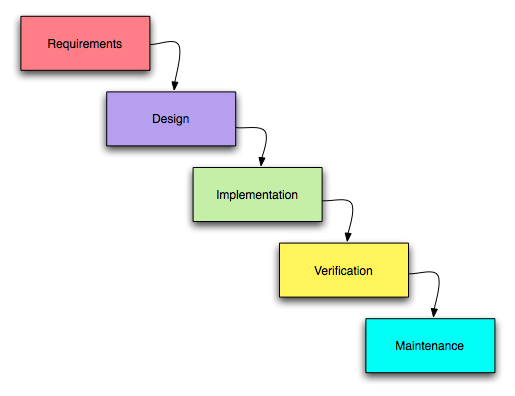
Image source: The Traditional Waterfall Approach
- Suited for well-defined projects with stable requirements.
- Use when a comprehensive plan and documentation are crucial.
- Less suitable for projects with evolving or unclear requirements.
Agile
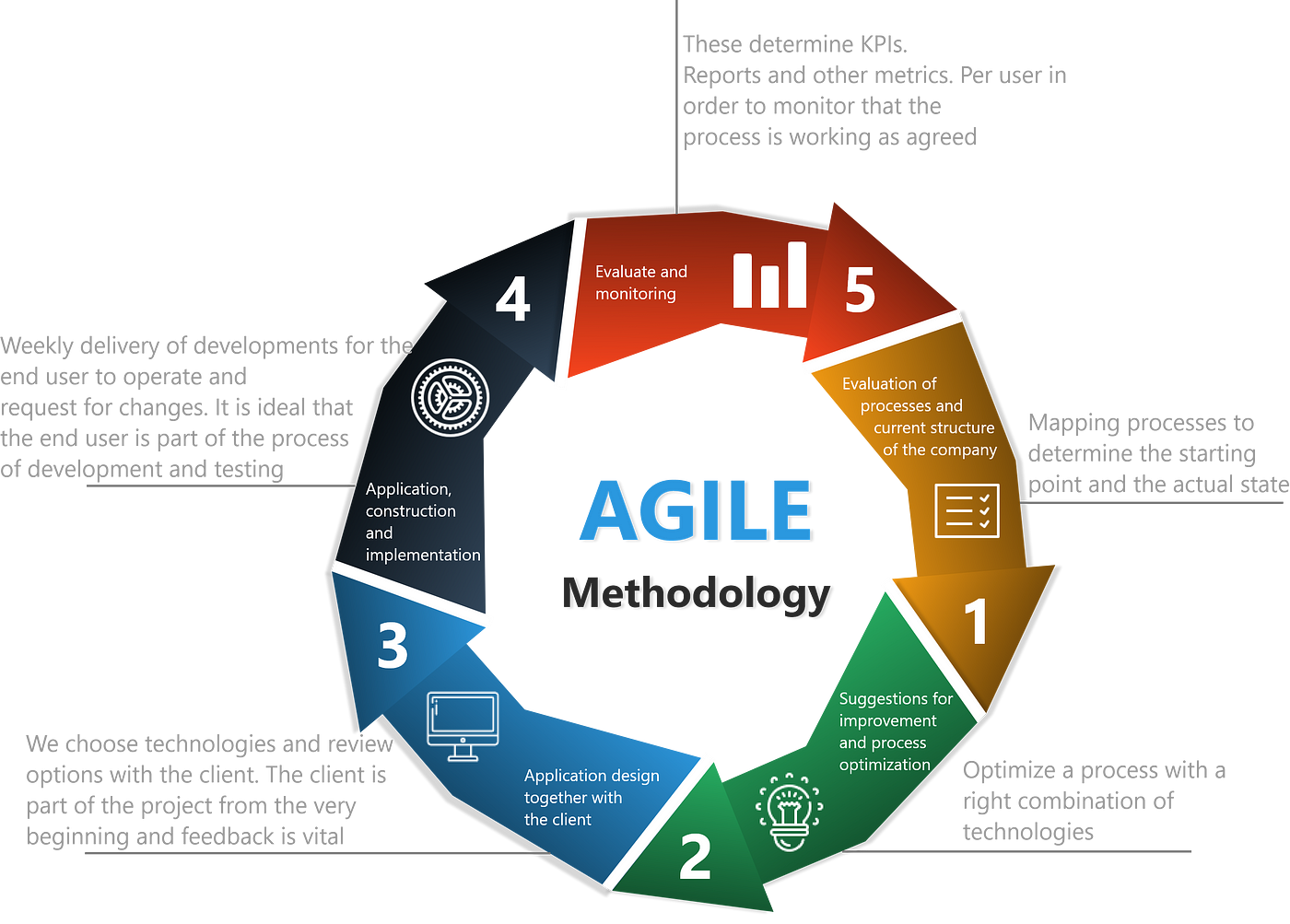
Image source: Agile Methodology
- Ideal for projects with changing or dynamic requirements.
- Enables quick adaptability to market changes.
- Promotes continuous improvement through iterative development cycles.
Agile Software Development Process
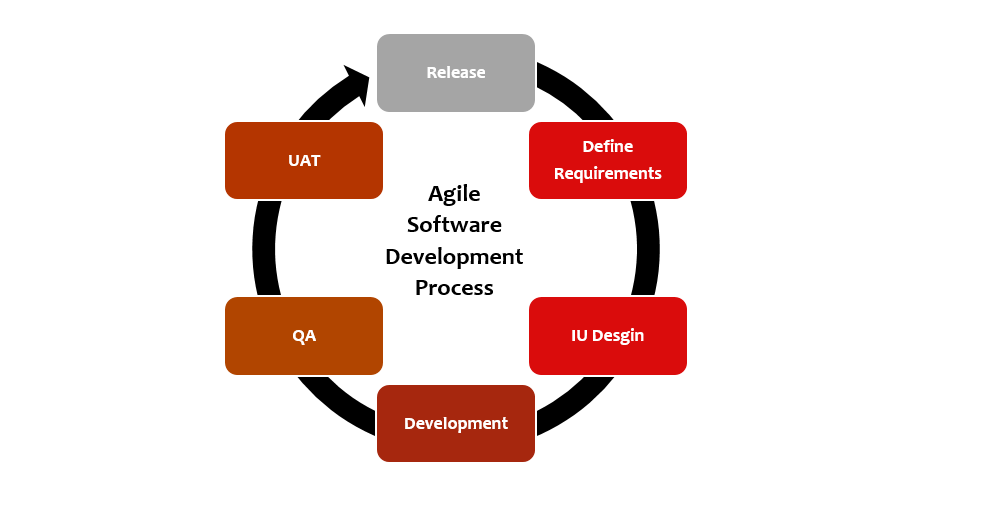
The Agile Software Development Process is distinguished by its iterative and adaptive nature, enabling teams to respond adeptly to evolving requirements. Key components, such as regular feedback loops, collaborative efforts, and a commitment to delivering value in concise cycles, contribute to the triumph of Agile projects.
Project Planning:
- Define the project scope, objectives, and requirements.
- Create a prioritized backlog of features and functionalities.
Sprint Planning:
- Select features from the backlog for the upcoming sprint.
- Break down tasks, estimate time, and set achievable goals for the sprint.
Development (Sprint Execution):
- Developers work on assigned tasks within the defined sprint duration.
- Conduct regular meetings (daily scrums) for updates and addressing impediments.
Testing:
- Conduct continuous testing throughout the sprint to promptly identify and resolve issues.
- Collaborate with developers for quick feedback and adjustments.
Review and Demonstration:
- Showcase completed features to stakeholders at the sprint’s end.
- Gather feedback for potential improvements and adjustments.
Sprint Retrospective:
- Evaluate the sprint’s successes and challenges.
- Identify areas for improvement and implement changes in the next sprint.
Repeat:
- Continue the cycle with a new sprint, incorporating feedback and adjusting priorities.
- Iteratively develop and enhance the product based on evolving requirements.
Continuous Integration and Deployment:
- Implement continuous integration practices for regular code merges.
- Automate deployment processes for swift and reliable releases.
Customer Feedback Integration:
- Continuously gather customer feedback, integrating it into subsequent sprints.
- Ensure alignment with evolving customer expectations and needs.
Adaptability:
- Embrace changes in project requirements or priorities.
- Maintain flexibility to respond to market dynamics and user feedback.
Collaboration:
- Foster a collaborative environment with open communication among team members.
- Encourage cross-functional collaboration to optimize the development process.
Prioritization and Backlog Refinement:
- Regularly review and prioritize the backlog based on changing project needs.
- Refine the backlog to ensure it reflects the current project priorities.
TechnBrains Software Development Process
At TechnBrains, our approach to software development is all about making things easy for you. We start by planning things carefully, making sure we understand exactly what you need. Usin Agile we can adapt quickly to any changes you want.
Keeping you in the loop, talking with you all the time to make sure we’re on the right track. Our team loves coming up with smart and creative solutions using the latest technology. We check and test everything a lot to make sure it works perfectly.
And even after we’re done, we keep making things better based on what we learn. TechnBrains makes sure you get software that not only meets but exceeds your expectations. You can also get an overview of the Custom Software Development Costs by visiting our blog. That’s how we roll at TechnBrains – making your vision a reality with top-notch, user-friendly solutions.
FAQs on Software Development Process
1. What are the steps of the development process for a software project?
The software development process typically includes stages like project planning, requirements gathering, design, coding, testing, deployment, and maintenance. Each phase contributes to the creation of a functional and reliable software product.
2. During which phase of the software development process are developers most likely to log bugs?
Developers are most likely to log bugs during the testing phase of the software development process. This stage focuses on identifying and addressing issues to ensure the software’s functionality and quality.
3. What are the steps in the software development process?
The steps in the software development process involve project planning, requirements analysis, design, coding, testing, deployment, and maintenance. These steps ensure a systematic and organized approach to software creation.
4. What are the 7 stages of the software development life cycle?
The seven stages of the software development life cycle (SDLC) are planning, requirements, design, implementation (coding), testing, deployment, and maintenance. Each stage contributes to the successful development and evolution of a software product.
5. What is the process of a software developer?
The process of a software developer involves understanding project requirements, designing the software architecture, coding, testing for quality assurance, deploying the software, and providing ongoing maintenance and support. Effective collaboration and adaptability are key aspects of a software developer’s process.
6. What are the 5 phases of the system development life cycle?
The five phases of the system development life cycle (SDLC) are planning, analysis, design, implementation, and maintenance. These phases guide the development and evolution of information systems, ensuring a structured and effective approach.








